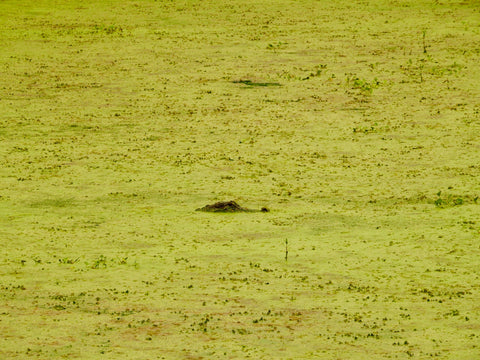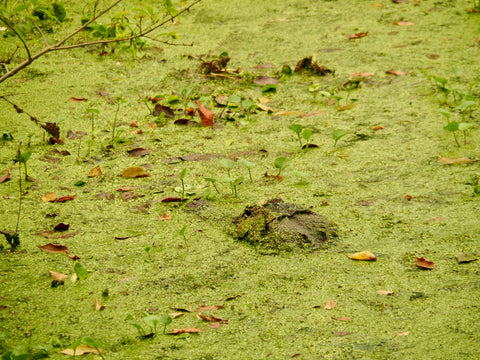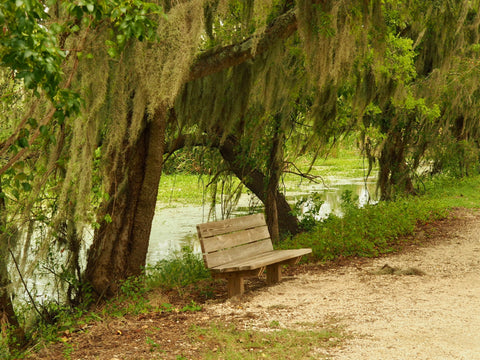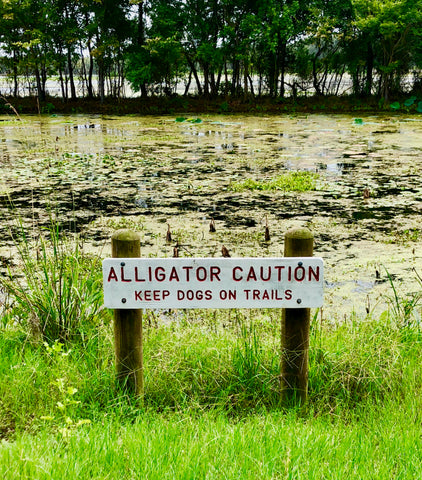Caution Alligators: Watch Your Step at Brazos Bend State Park
Concealed by the rattle of locusts, loud cries of waterfowl and the hum of bullfrogs silently the alligator peeks above the water's surface. So adept at swamp life in the southeastern United States, the American alligator (Alligator mississppiensis) has remained biologically unchanged for 8 million years. In the mid-twentieth century, the American alligator was nearly hunted to extinction for its skin and subsequently listed as an endangered species in 1967. Collaborative conservation efforts by several southern states increased the large reptile's population count to a stable level within 20 years. The American alligator is currently protected from over hunting but the largest threat to the species is from urban sprawl and habitat loss.

The American Alligator is the largest reptile in the United States. Males can grow up to 15 feet in length weighing nearly 1000 pounds.
Less than 50 miles from downtown Houston is a primordial landscape reminiscent of a Jurrasic Park movie where large ancient reptiles await their next victim. Or so it feels hiking the meandering trails that lead through marsh and moss-covered forest at Brazos Bend State Park. Amongst the wetlands, visitors will encounter many of the over 300 resident alligators living in the protected 5000 acres of native countryside.

A primordial world
Brazos Bend State Park is home to hundreds of birds, 21 species of reptiles and dozens of native mammals including the gray fox, the southern flying squirrel, bobcats, coyotes, river otters and 7 species of bats. Most of the park is in the Brazos River floodplain with a bottomland forest, swampy wetlands, and oxbow lakes cut off from the ancient Brazos river. Along the western edge of the property is a restored tallgrass coastal prairie that is reminiscent of a once widespread but vanishing ecosystem. The previous landowners grazed cattle on the grassland plain but historically the grasses provided for millions of buffalo. Archeological human remains date back as early as 300 BCE.
In addition to the Brazos river and coastal prairie, Big Creek is another water source that meanders diagonally through the park and is associated with the sloughs and bayous throughout. Constructed levees bisect the creek to control flooding and create walkways for nature seekers. There are over 40 miles of hiking and biking trails with observation towers and platforms for wildlife viewing.
Cody and I began our journey in the afternoon on a late summer day in August. The heat was upon us and the alligators. During the hot summer months, the cold-blooded reptiles enjoy hiding in the cooler temperatures of the lakes and ponds. Only the ominous eyes and snouts protrude from the green algae covered surface. The grey, brownish or black skins of the American alligator resemble a floating log. At first, we observe one obvious gator underneath an observation dock. A little disappointed we continued walking for nearly a mile between two lakes before we heard a commotion in the lotus-covered wetlands to our left. As the alligator finished whatever business it had attended to, it quickly camouflaged back into a dead tree branch. At that moment, Cody and I caught sight of how many of the floating logs were actually alligators and that we had been surrounded the whole time. A serious chill passed through me and I was paralyzed for a brief moment examining all escape routes. Further ahead was a group with small children and behind a couple with a dog, surely I wasn't the number one choice for a late lunch. I relaxed a little while Cody snapped dozens of photographs and a video.

Alligator Soup

Watch your step. This alligator was resting a mere 10 feet from the path.
40 Acre, Elm, and Horseshoe Lake trails are located near the park entrance. Many of the resident alligators reside in the areas along these 4 miles of trails. The terrain is flat and the pathways are well maintained for hiking and biking. Beyond the pond life, we observed giant banana spiders, dozens of swallowtail butterflies, late summer sunflowers, and native grasses beginning their plume spikes for a spectacular fiery fall display.

The day was lush and balmy underneath the moss-covered oaks. We leisurely strolled the 4 miles in a couple of hours stopping often to view the gators in slow motion action. Cody and I felt refreshed from the pause in the hurried pace of the modern world. We will soon return in hopes of spotting alligators basking across the trails in the warm autumn sunshine. With much caution, of course.

Brazos Bend State Park is an extraordinary experience in an ancient world where reptiles rule. Alligators are a keystone species in the wild helping to keep ecosystems in balance. Preserving wild spaces will not only protect wildlife but the diversity of plant life absorbs carbon from the atmosphere. Visting these amazing habitats help support their continued existence and expansion making a better, brighter future for us all.

Leave a comment
Please note, comments must be approved before they are published